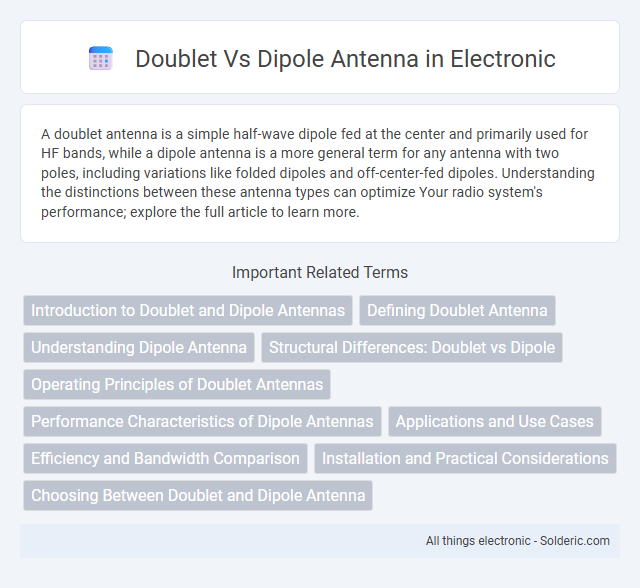A doublet antenna is a simple half-wave dipole fed at the center and primarily used for HF bands, while a dipole antenna is a more general term for any antenna with two poles, including variations like folded dipoles and off-center-fed dipoles. Understanding the distinctions between these antenna types can optimize Your radio system's performance; explore the full article to learn more.
Comparison Table
| Feature | Doublet Antenna | Dipole Antenna |
|---|---|---|
| Definition | Two-wire antenna with variable length elements, not necessarily half-wave. | Half-wave antenna with two equal-length conductive elements. |
| Element Length | Variable; often not exactly half wavelength. | Precisely half the wavelength of the signal frequency. |
| Impedance | Variable; depends on length and feed point. | Typically around 72 ohms in free space. |
| Radiation Pattern | Broadside pattern with lobes depending on length. | Figure-eight pattern perpendicular to antenna axis. |
| Applications | General HF communication, adaptable setups. | Common in FM, HF, and VHF radio communications. |
| Feeding Method | Feed point varies; balanced or unbalanced feed possible. | Typically fed at center with balanced feed line. |
Introduction to Doublet and Dipole Antennas
Doublet and dipole antennas serve as fundamental elements in wireless communication systems, with the dipole antenna consisting of two equal-length conductive elements symmetrically arranged around a feed point. The doublet antenna, often considered a variation of the dipole, can have unequal arm lengths and is primarily used for broad frequency coverage and multiband operation. Both antennas operate on the principle of resonant current distribution, making them essential for efficient transmission and reception in HF and VHF bands.
Defining Doublet Antenna
A doublet antenna consists of two equal-length conductive elements arranged in a straight line, typically driven at the center, creating a balanced and symmetrical radiation pattern. Unlike a dipole antenna, which usually has a specific length related to half the wavelength, a doublet's length can vary based on the frequency band and operational requirements. This makes the doublet antenna a versatile choice for multi-band HF communication, enabling efficient transmission and reception over a wide frequency range.
Understanding Dipole Antenna
A dipole antenna consists of two conductive elements typically wired as equal-length rods or wires, designed to transmit or receive radio frequency signals efficiently. It operates by creating an alternating electric current that generates electromagnetic waves, providing a radiation pattern ideal for many communication applications. Understanding the dipole antenna helps you optimize signal strength and polarization for your wireless transmission needs.
Structural Differences: Doublet vs Dipole
A doublet antenna typically consists of two equal-length conductive elements connected at the center, whereas a dipole antenna specifically refers to a balanced doublet with elements half a wavelength long. The doublet can be any length and is often fed with balanced line or ladder line, while the dipole's length is precisely tuned to resonance at a particular frequency. Structurally, the dipole's fixed half-wave elements offer predictable impedance characteristics, contrasting with the doublet's versatile element lengths and feeding methods.
Operating Principles of Doublet Antennas
Doublet antennas operate based on the principle of resonant half-wave elements that radiate electromagnetic waves efficiently at their design frequency. The antenna consists of two equal-length conductive elements fed at the center, creating a balanced current distribution that produces a predictable radiation pattern. Understanding these operating principles helps you optimize antenna placement and tuning for improved signal strength and transmission quality.
Performance Characteristics of Dipole Antennas
Dipole antennas exhibit uniform radiation patterns with balanced impedance, typically around 73 ohms, enhancing signal clarity and transmission efficiency compared to doublet antennas. Their performance excels in minimizing noise and maximizing gain, especially in HF and VHF frequency bands, making them ideal for both amateur and professional communication. Your choice of a dipole antenna ensures reliable, broad-frequency coverage with optimal directionality and reduced signal loss.
Applications and Use Cases
Doublet antennas are widely used in amateur radio and shortwave listening due to their simple design and effective multiband capabilities, making them ideal for HF communications. Dipole antennas are commonly employed in broadcast and cellular networks, providing efficient radiation patterns for VHF and UHF frequency bands. Both antenna types serve critical roles in wireless communication systems, with doublets favored for their versatility in experimental setups and dipoles preferred for stable, fixed installations.
Efficiency and Bandwidth Comparison
Doublet antennas generally offer broader bandwidth due to their longer elements and simpler resonance characteristics, making them effective for multi-band operation. Dipole antennas typically provide higher efficiency with better impedance matching at specific resonant frequencies, reducing power loss in transmission. Efficiency in dipole designs often results from optimized conductor length and minimal energy dissipation, whereas doublets trade some efficiency for their wider frequency coverage.
Installation and Practical Considerations
Doublet antennas require a balanced feedline and precise positioning to avoid interference, making their installation slightly more complex than dipole antennas. Dipole antennas, often fed with coaxial cables, offer simpler grounding and mounting options, providing easier setup for most users. Your choice should consider available space, feedline compatibility, and ease of maintenance to optimize performance.
Choosing Between Doublet and Dipole Antenna
Choosing between a doublet and dipole antenna depends on frequency range and installation constraints; a doublet antenna offers versatility with balanced feed and is ideal for multi-band operation using an antenna tuner, whereas a dipole antenna provides simplicity with a fixed length resonant on a single frequency. For HF communications, doublets accommodate variable frequencies and heights, enhancing radiation patterns, while dipoles excel in narrowband applications with minimal matching components. Consider antenna environment, desired bandwidth, and feedline compatibility when selecting the optimal antenna type.
doublet vs dipole antenna Infographic

 solderic.com
solderic.com